Getting bit by a dog can be a scary event, and even if you sometimes try your best to prevent this from happening, you might still get bit. That’s why in this article we’ll tackle the reasons why dogs bite, seeing as deciphering the first signs by which the dog tells you he will soon become aggressive is the best way to keep you safe.
[the_ad_placement id=”in-text-1-type-r”]We’ll also discuss prevention means both for adults and for children – they are sadly more prone to being bitten since they’re smaller and they can’t react sensibly to the dog’s cues. Last but not least, even if we think that prevention is actually the best cure, we’ll go through everything you need to know regarding a dog bite treatment, so you can be thoroughly prepared.
Causes why dogs bite
Dogs bite because of a lot of reasons and even if you may think it’s malice or aggressiveness, in most cases it’s just a defensive behavior. So what do dogs have to be on the guard about?
Something they have
If you’re getting too close to the place where the dog has food, water or maybe a litter of puppies, you can get bit. The reason is that the dog sees you threatening his most essential belongings which can be equaled to his survival. You can avoid this bite easier if you’re not dealing with a stray dog, since the owner can advise you where not to go.
Their owner and their property
Dogs are very loyal creatures by instinct, and they’ll stop at nothing for their humans. On the other hand, dogs are also quite territorial, so if they feel you’re trespassing or taking too many liberties on their territory, they’ll put you on your place. So try reading the dog’s nonverbal cues and slowly move away from the place or person they consider off limits.
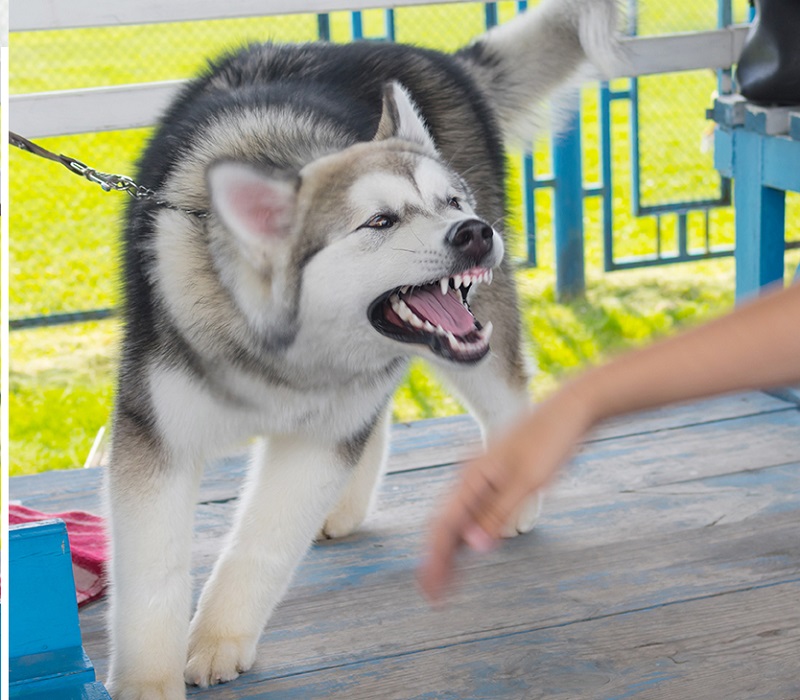
You should never try taking things the dog has or moving too much in his space just because it’s fun testing his limits. Oftentimes children may find this sort of thing amusing, and if you see yours taunting a dog, you’d better quickly stop the game.
Himself
If you’re dealing with an older, grumpier dog, he might not have enough patience to be dealing with humans the nice way, so you should be extra careful around him. You should also never disregard a sick or injured dog as helpless and therefore gentle, because this type of pooch actually becomes more threatened by your actions and hence more likely to bite.
Moreover, a dog can bite on the off chance you injured him yourself by mistake, by stepping on him or by playing with him too rough.
The “sheep”
If the dog comes from a herding breed he may see all humans – but especially children – like his sheep, the animals he has to keep in one place. So if he hasn’t learned bite inhibition yet, he may have a nipping tendency which can be enhanced if you start acting uncontrollably or aggressively towards him.
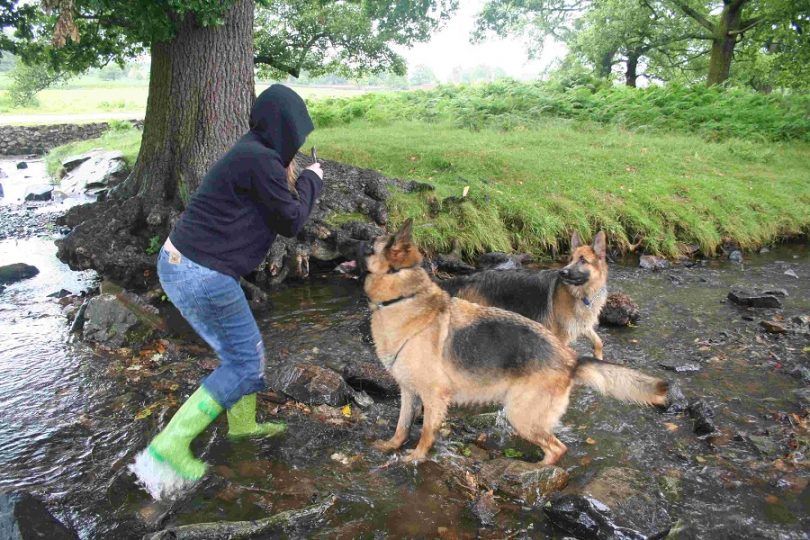
So don’t scream, run, or try to shove him away – he will punish you like the unruly sheep that you are.
The prevention treatment
As we’ve said before, prevention is the best treatment for dog bites and you should know that a dog doesn’t just bite out of the blue, but there are always signs which indicate the possibility of this happening.
See also: How to Avoid Wild Animal Attacks: Surviving Outdoors
However, these cues can be really imperceptible for humans and his annoyance may be mistaken for tolerance. And surprisingly, a very long time, even months, can pass before the dog feels he has had enough and proceeds to bite the unsuspecting victim who hasn’t understood the cues below.
- The dog tries to get away from you.
- The dog frequently turns his head in the opposite direction from your face.
- The dog often looks at you with a defensive countenance.
- The dog isn’t excited to be around you, but instead yawns when you try to interact with him.
- The dog licks himself frequently after you have stopped petting him.
But these are the signs that can be noticed only very subtly and for an increasing amount of time prior to the actual incident. On the other hand, there are other signs which show the dog is getting ready to bite you now, hence his body language will show very strong feelings of aggressiveness, defensiveness or apprehension such as:
Making himself look bigger
An aggressive dog adopts this strategy because he’s letting you know that he’s not one to be trifled with since he’s big and strong.
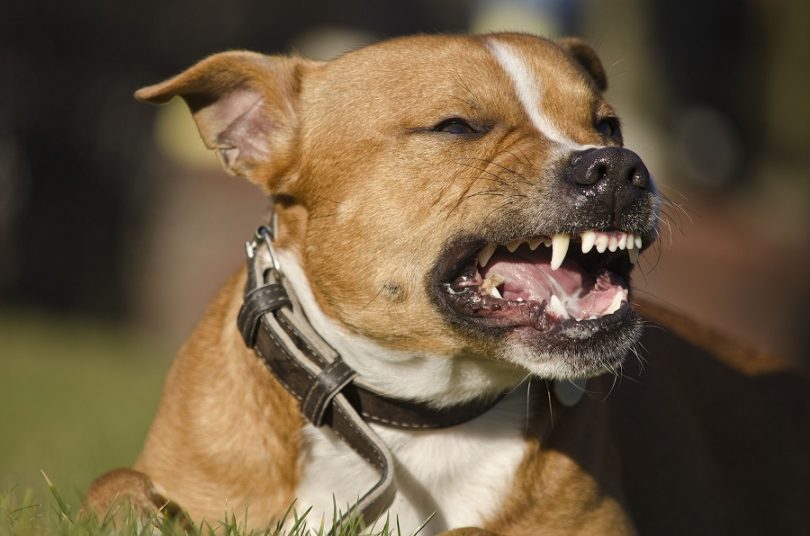
So here’s how dogs make themselves appear more impressive:
- The ears are up and forward.
- The fur on their back and/ or tail can stand up.
- The tail is kept straight up, and can sometimes wag.
- The stance is stiff, and the legs are straight.
- Staring directly at you and moving toward you.
- Showing their teeth, while they growl or bark.
Making himself look smaller
If, conversely, the dog in question is very scared or anxious he will try the opposite strategy of making himself look smaller, therefore conveying you the following message: “Hey, I’m not a threat to you, but I’ll defend myself if push comes to shove!”. The dog does this by:
- Crouching on the ground.
- Lowering his head.
- Repeatedly licking his mouth.
- Putting his tail between his legs.
- Flattening his years back.
- Yawning.
- Avoiding direct eye contact.
- Exposing his belly.
- Defensively growling.
- Trying to retreat slowly from you.
Sending mixed signals
Some dogs may very well use cues from both of the above categories indiscriminately, since real life situations aren’t all black and white.
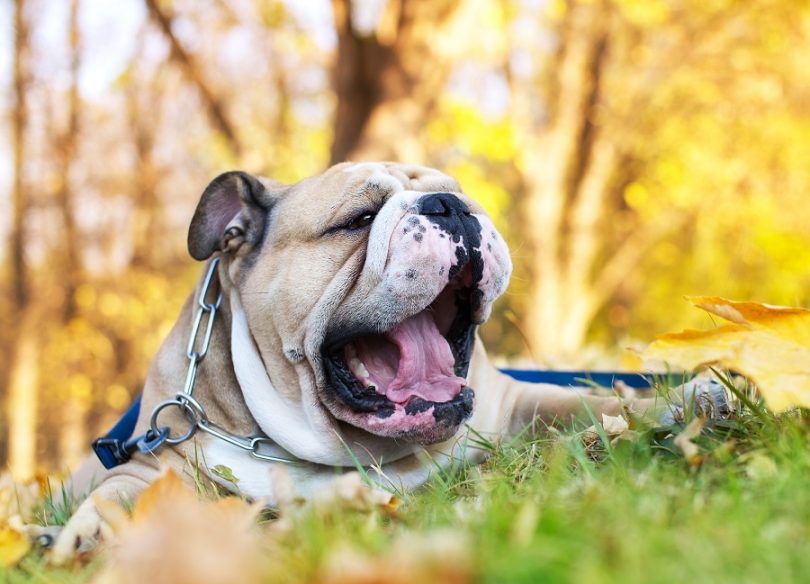
Basically, it’s better to just stay away from any dog which shows fear or aggression around you, and try not to mistake an apprehensive or defensive behavior with a docile, obedient one.
The prevention treatment continued: safety advice
Since any dog can bite your kid, even the most innocent looking one or even the smallest one, it’s best to advise your kids never to provoke a dog. He may seem friendly and cute, but if he feels threatened he will act instinctively.
Surprisingly, statistics show that most dog bites don’t come from strays but from dogs you actually know, and that’s why learning how to read their cues and behave accordingly around them is something children have to learn.
Besides, kids often are impulsive and loud, apart from enjoying a good run. However, all these actions are perceived as aggressive by dogs, even if the kid has no intention to harm him.
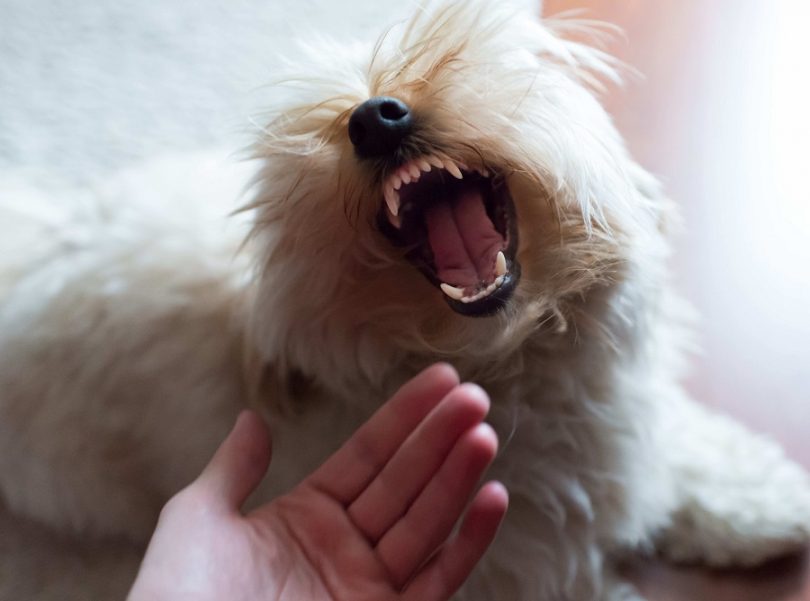
That being said, you should not:
- Get near, touch or try to play a dog that’s doing something else, like eating, playing or sleeping. You should especially avoid female dogs that are interacting with their puppies, because that drastically increases the chance of bites.
- Get near a dog that’s growling, snarling, barking or otherwise obviously aggressive.
- Approach a dog that is evidently scared by you.
- Try to pet or play with dogs you’ve never seen before. The best thing to do is ask the dog owner, and only if they say that everything is fine should you get near the dog.
- Try to pet an unfamiliar dog on the head. That’s the first and most common mistake we do when we try to interact with dogs, when we should actually ask for his approval by letting him smell our hand and gently touching him under his mouth.
- Try to touch a dog that’s in an enclosed space, because dogs are very territorial.
- Run, cry or scream if a dog approaches. In fact, that only rouses the dog’s hunting or herding instincts, and sees you/ your kid as either prey or errant sheep. The best course of action is standing perfectly still and quiet till the dog looses interest, and only afterwards move slowly away.
- Struggle or fret after a fall. If your kid fell on the ground after trying to run away from the dog, he should remain still and curl up in a fetal like position, making a sort of ball out of himself by tucking his knees in his stomach and placing his arms around his head to protect his neck. That will determine the dog to sniff him and then go away.
- Outrun a dog. In case of an actual attack, outrunning the dog is not only impossible but also awakens the dog’s chasing instincts. Therefore, an attack can be solved better by distracting the dog’s attention toward some other “enemy”, like your jacket or bag, which can be interposed between you and his terminator jaws.
Prevention advice for pet owners
If you yourself have a dog, you must know that they’re unpredictable animals unless they’re properly trained, and even if you can never 100% guarantee that your dog won’t bite someone, obedience training is the best chance to really reduce the risk of your dog harming another human being.
[the_ad_placement id=”in-text-2-type-r”]Here are some tips you need to follow in order to further reduce the chances of your dog biting:
Adopt from a trustworthy animal shelter
That way you’ll have the dog’s whole history, including his parents, his personality and the way he acts around other people and dogs.
Neuter the dog fast
Neutered or spayed dogs are less aggressive and therefore less likely to bite. The best time is before his first heat, and the dog can be as young as 2 months, provided he’s healthy enough to withstand this medical procedure.
Socialize the dog
A dog that has undergone an adequate socialization process will be more confident and rational. Contrariwise, a dog who hasn’t been around other people or animals frequently is more likely to make impulsive decisions based on fear, which translates into an increased likelihood of aggression and biting.
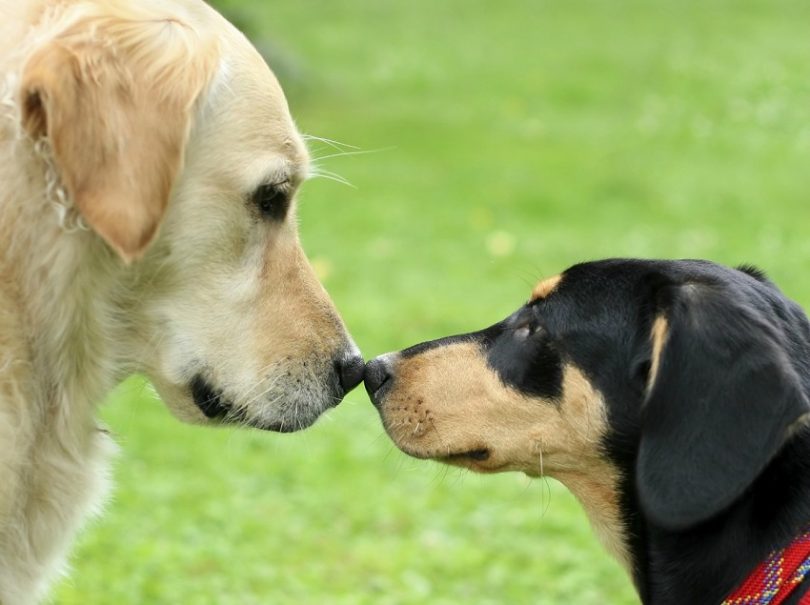
When you socialize the dog, you give him the chance to really know his environment and learn new, awesome things about it everyday. Therefore, he will feel comfortable and at ease in all sorts of new situations instead of getting scared and feeling the need to defend himself.
However, don’t push your dog to make fast progress, but let him explore at his own convenience the world around him.
Train your dog
Obedience training can start as early as 8 weeks, and you can either take the dog to training classes or do the necessary research and teach him the basics on your own. The most important thing is to be calm, constant, assertive and show the dog that he has nothing to fear when you’re around. Obedience training serves as an effective communication between you and your dog, and therefore he will learn to suppress his instincts and follow your commands.
Make him feel loved
If your dog spends a lot of time on his own, away from you and your family, in an enclosed space or even chained, he will become very frustrated and feel scared. That’s why dogs that aren’t truly considered part of their human family are more likely to bite – their aggressive tendencies are cultivated through isolation, fear and boredom.
Know the cues
If you have made your dog really part of your family, you probably must understand his nonverbal behavior, as well as what triggers him. If he’s in pain, ill or hurt, if he doesn’t like strangers, the postman or other dogs, if he hates loud noises like fireworks and storms, pay extra attention to his behavior and supervise him more when he gets in an uncomfortable, triggering situation for him.
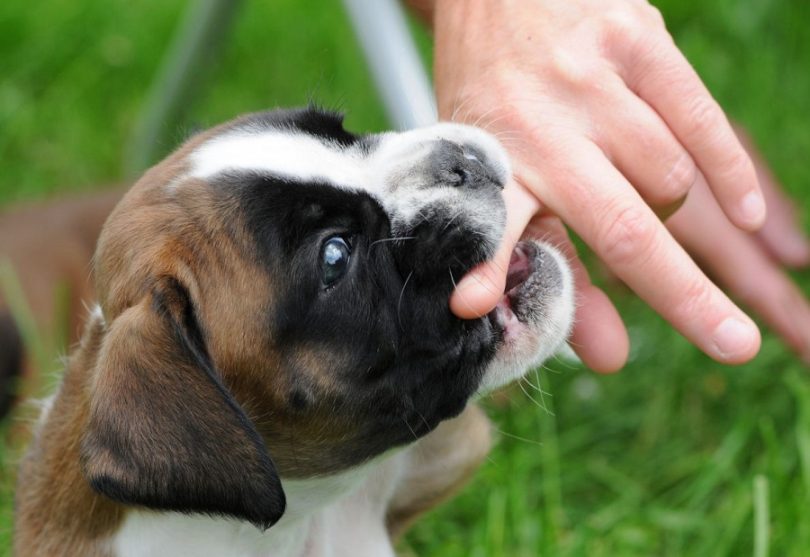
If he shows signs of apprehension and fear to your visitors, it’s best to keep him on a leash or put on a muzzle until he gets more familiar or comfortable around new people. You can then gradually remove these restrictions, once the dog has shown an improved, more accepting behavior.
Never leave your dog unsupervised with kids
Since younger kids and toddlers are often unpredictable, loud and have tendencies to play roughly, it’s best to be in the same room with them and the dog. At first you can put a muzzle on your dog just to be safe, but the kids should also learn how and when to get near the dog, how and when it’s okay to play with him and why they should respect his safe space.
Vaccinate your dog
As we’ve said before, you can never 100% prevent your dog from biting other people – you included – and that’s why you should keep his vaccines up to date, and take him to the vet as often as necessary. Dog bites are dangerous because they can transmit all sorts of parasites as well as rabies, if he isn’t properly immunized.
Medical interventions in case of dog bites
The medical treatment for dog bites is something you can familiarize yourself with, especially if you have an aggressive dog, if one of your friends has a dog like that or if you live in a dangerous neighborhood with lost of strays.
That being said, if you’re a victim of a dog bite, you need to get to somewhere safe as soon as possible, to avoid being bitten again. Make sure you are ready for anything. Our piece on how to assemble a complete first aid kit is a good read, check it out.
Once you’re safe, you can attempt cleaning the wound yourself and disinfect it properly with hydrogen peroxide before actually going to the hospital. You can even bandage it and apply a tourniquet to prevent the risk of infections. The best thing would be to keep your limb elevated, particularly if the bite mark is pretty deep and if there’s a lot of blood, in order to help the blood coagulate faster and the wound to close. Check out our article on how to tell if a wound is infected to serve as you guide.
Besides this, if you know the dog’s owner, they should be able to provide you with valuable information regarding his medical history and weather he has been vaccinated against rabies.
If you’ve been attacked by a stray dog, you can obtain these details either with the help of animal control centers or with the aid of law enforcement.
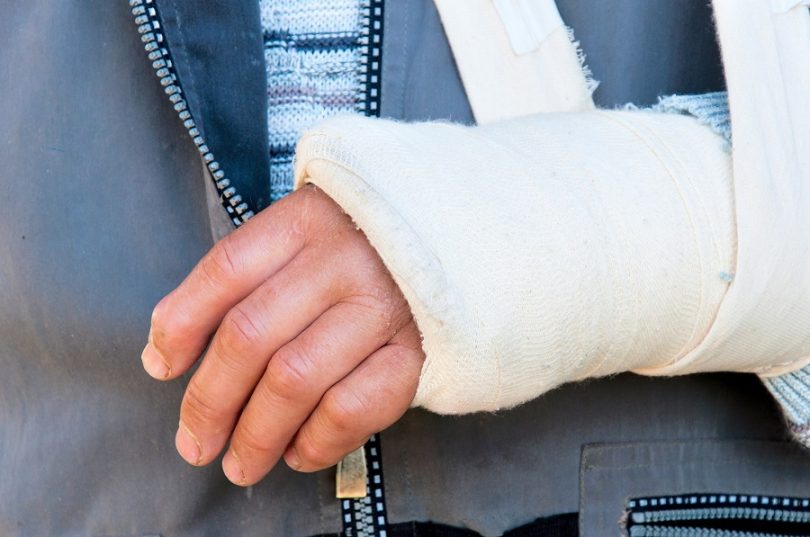
However, because dog wounds are pretty dangerous and you can’t assess yourself the type of damage that has been done under your skin or what infection may have been transmitted, it’s always best to seek medical attention and go immediately to the hospital.
You should go to the doctor without delay particularly if you notice that the wound is beginning to puncture or lacerate. Besides, if the injury starts feeling really painful that’s a trigger warning of something more dangerous going on beneath the superficial skin level, like an infection.
The signs of infection in case of a dog bite include:
- Pain.
- Redness.
- Warmth.
- Swelling.
- Drainage/ pus from the wound.
- Fever.
People who don’t experience these symptoms may not want to go to the doctor, especially if the wound isn’t really deep or presenting abrasions. In these situations, you should nevertheless check the rabies status of the perpetrator-dog immediately, because if he has rabies you need to be treated fast. That’s because rabies can be successfully cured when it’s discovered in its early stages, but if it goes undetected it’s a fatal disease which causes the victim’s death
Treatment issues in dog bites
That being said, dog bites have to be treated at 3 levels:
- The superficial skin wound.
- The internal injury to muscle, bone and nerves.
- The possible infection associated with the bite.
As such, even though the skin wound may appear pretty bad, it’s also not as significant as the internal damage done to your organs or bones. The reason why most people seem more interested in their esthetic look is that they see it as an important indicator of what’s beneath it.
Unfortunately, you can have a small, okay-looking injury on the outside and really extensive damage on the inside. That’s why the doctor will concentrate more on the injuries which have the potential of leaving your body unable to perform its normal functions.
Moreover, if you get a nasty looking wound to your hand, you shouldn’t think too much at the potential for scarring – which, we admit, is pretty high – but be more concerned about a cut tendon that can keep your hand from moving properly.
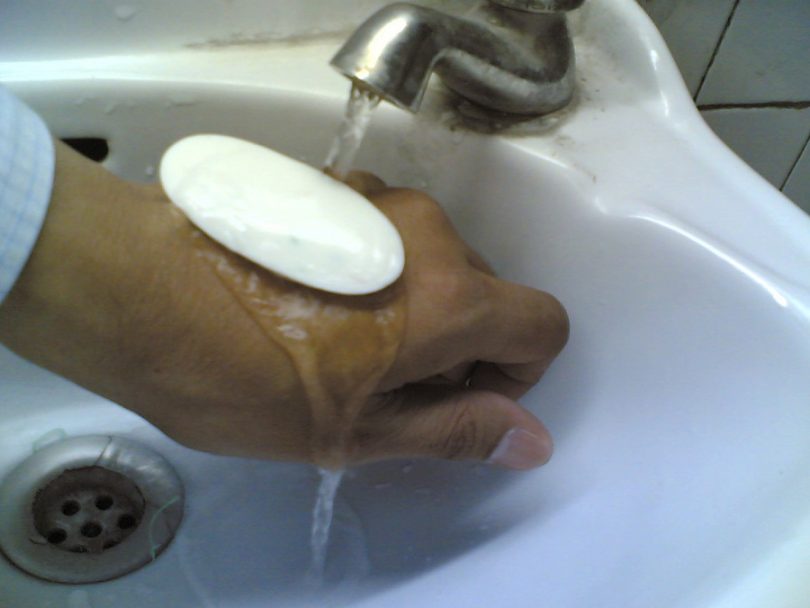
In addition to this you should also not ignore the risks of infection, because along with the bite bacteria from the dog’s mouth can be transmitted to your bloodstream, or can be transferred to your muscles and really damage your internal organs. The most common bacteria transmitted through a dog’s saliva during the bite are:
- Streptococcus.
- Staphylococcus.
- Pasteurella.
- Rabies.
The medical consult
When you’re going to the doctor for a treatment to your dog bite, you’ll probably have to answer these questions regarding the attack and your medical history:
- Can the dog be available for observation?
- Was it a defensive bite or an aggressive one?
- Where’s the bite?
- What is your medical history?
Afterwards, you will be examined in order to asses whether there’s been any damage to your muscles, tendons, nerves or bones.
Next, you will undergo local anesthesia for the wound to be properly checked. That way, the doctor can confirm if you have internal damage.
[the_ad_placement id=”in-text-3-type-r”]Once these steps are completed, the doctor can proceed to cleaning your wound in order to get all the dirt and bacteria out, by using a saline solution. If you don’t seem at risk for infection, your injury will be sutured for esthetic reasons regarding the later appearance of your scar. Conversely, if your risk of infection is high, the wound will be left to heal on its own.
But apart from this, if the injury looks pretty bad and if it’s deep, you may even need to undergo surgical treatment. This generally happens when you’ve lost a lot of skin and blood, and if your internal organs are affected. However, if the dog bit your face, you may also need total anesthesia to keep you still under the painful procedure.
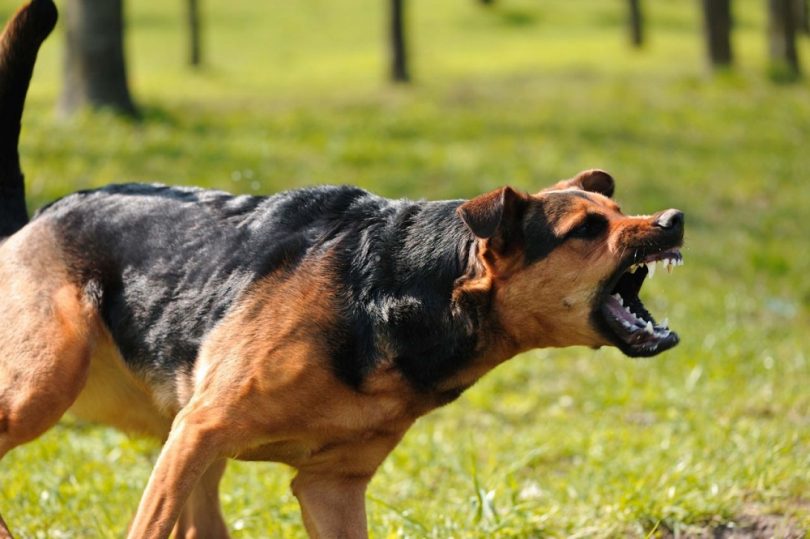
Last but not least, you may be prescribed some antibiotics to help you heal faster, even if there’s no obvious sign of infection – but that depends more on how your doctor assesses the whole situation.
That being said, we maintain our opinion that prevention is key and the best way to treat 99% of any dog bites. So, be wary of dogs’ nonverbal communication, keep your kids safe and avoid dangerous places where strays roam in packs.




If you are a dog owner, it is your responsibility to prevent dog bites. It is also advisable to avoid those long retractable leashes because it does not give you full control of your dog. Even though my friend walked to the other side of the street, a dog was stil able to reach her because the owner used the retractable leash. This is despite his dog’s history of biting people while he is being taken out for a walk. The owner even claimed it was my friend’s fault for not moving too fast to avoid his dog.
I often hear people repeat the advice to hold your hand in front of the mouth of a dog who does not know you to let them smell you. This is not good advice at all. It is better to ignore the dog first and just talk to the owner and let the dog come to you and smell you himself. Also don’t mistake the dog wagging it’s tail to always mean it is friendly. If you have kids, make them understand how important it is not to go near dogs that they do not know, especially ones that do not have their owner nearby.
That’s good thinking, Matthew, but it is always wise to pay close attention to the dog’s body language, including tense body, intense stare, furrowed brow, and stiff tail. These are danger signs, conveying a very simple message-STAY AWAY!
It is the owner’s responsibility to ensure that his or her dog is under control. However, if you find yourself in a surprise dog attack – feed the dog your jacket, purse, or anything that you can use to prevent the bite, and then TAKE OFF!